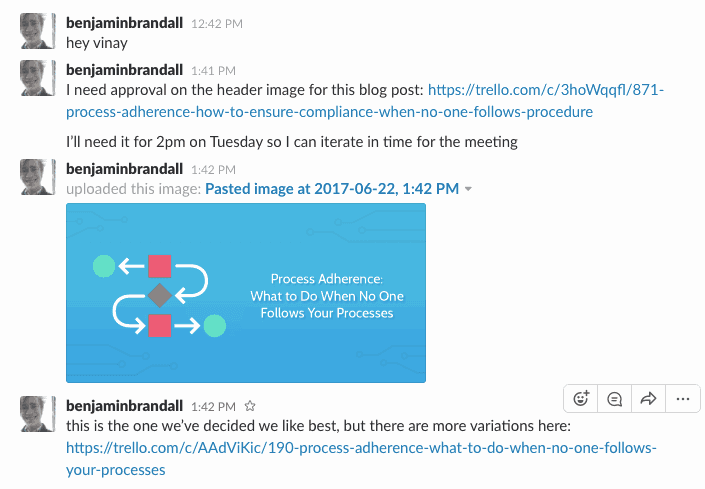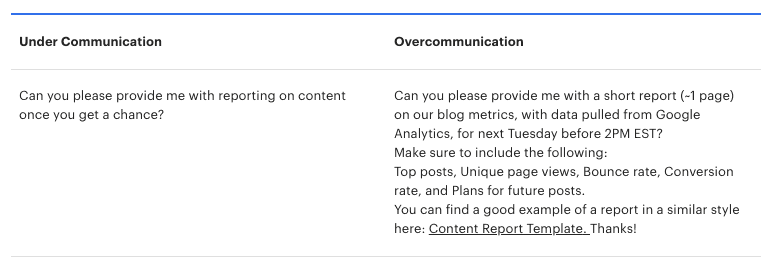If you’re a project manager, you’re probably always on the lookout for ways to improve your skills. Fortunately, the internet is full of useful tips, tricks, and best practices to help you do so. One tip that doesn’t get talked about enough, though, is asynchronous communication.
In this article, we’ll discuss what asynchronous communication is, why it’s beneficial, and eight ways project managers can use it to better manage tasks. Let’s dive in!
What is Asynchronous Communication?
Asynchronous communication is any form of communication that does NOT happen in real time. If you send an email, for example, without expecting an immediate response from the recipient, you’re communicating asynchronously.
Asynchronous communication is the opposite of synchronous communication, which is defined as communication that happens in real time. When information is given and responded to immediately, the communicators are engaged in synchronous communication.
The following chart shows the typical asynchronous and synchronous communication channels used by business professionals:
Asynchronous Communication
- Slack, Facebook Messenger, etc.
- Asana, Trello, etc.
Synchronous Communication
- In-person meetings
- Phone calls
- Video conferences
The Benefits of Asynchronous Communication
There are many benefits associated with asynchronous communication, but the two outlined below are, in our opinion, the most important. Let’s take a quick look at each:
1. Greater Team Productivity
Because team members aren’t required to immediately respond to the asynchronous messages they received, they’re free to plan their day in the most productive way possible. This will allow them to turn off notifications and remove other distractions that prevent deep work.
It takes about 23 minutes to refocus after an interruption. By committing to asynchronous communication, you and your team will work better and more efficiently because your workday won’t be disrupted by constant messages.
2. Fewer Time-Zone Challenges
Asynchronous communication also leads to fewer time-zone challenges, which is especially important for distributed and/or remote teams.
If you’re working in Seattle, Washington and your colleagues are based out of London, England, you’ll obviously be working at different times. If you expect your partners in the U.K. to immediately respond to messages, you’ll be sorely disappointed.
Fortunately, because asynchronous communication doesn’t require constant back and forth between team members, it reduces the challenges faced by teams in different time zones.
Asynchronous Communication Tips For Project Management
Asynchronous communication will benefit most employees in a wide variety of organizations — including project management professionals. Here are eight tips you can use to supercharge your project management skills using asynchronous communication best practices.
1. Don’t Micromanage Your Team
Micromanaging your team is rarely a good idea. In fact, studies prove that doing so often leads to low employee morale, high staff turnover, and a reduction in team productivity.
These negative side effects should be reason enough for you to avoid micromanagement. But if you’re looking for one more, know that asynchronous communication simply doesn’t work for micromanaged teams. If you’re constantly telling your employees to read messages at specific times, you’re missing the point of this communication style.
So, in general, allow your team to respond to messages when it suits them.
But don’t worry, we’ll give you tips in the following sections to ensure your messages are responded to in a timely manner — asynchronous communication is great, but if you always have to wait a week for a response, your project management efforts won’t be successful.
The key is finding the balance between asynchronous and synchronous communication styles, without micromanaging your team at every turn.
2. Schedule Specific Communication Times
Like we just mentioned, asynchronous communication doesn’t mean no communication, or “I’ll communicate with you when I feel like.” It simply means that you and your team aren’t forced to immediately respond to the messages you’re sent.
With this in mind, we suggest scheduling specific communication times throughout your day.
For example, you might decide to answer emails from 9am to 9:30am every morning. Then check your messages again right after lunch from 12:30pm to 1pm. If you feel the need, you could plan to check emails one last time in the evening before signing off for the day.
But in between these scheduled communication times, be sure to turn off notifications and not check your email, Slack, etc.. That way you can focus on the projects you’re currently managing and reach peak productivity.
3. Add Time Buffers Into Your Schedule
Even the best asynchronous communicators will need to occasionally break from tradition and respond to messages in real-time. What if a project suddenly takes a turn for the worst? You’re going to want to contact your team and promptly remedy the issues.
That’s why it makes sense to add time buffers into your schedule.
Plan to respond to messages from 9am – 9:30am (or whatever time works for your unique schedule). But don’t jam pack the rest of your day with so much work that you quickly fall behind if you’re forced to spend a few extra minutes addressing unforeseen challenges.
4. Be Specific in Your Messages
So far we’ve covered a few high-level tips. Now it’s time to get into the nitty-gritty of effective asynchronous communication, starting with the need to be specific in all your messages.
If you’re not going to immediately respond to your employees and/or colleagues, it would behoove you to make sure that the messages you do send are as specific as possible. You don’t want your team to have to wait around, unable to complete their own tasks, because they can’t decipher the vague email you sent them.
Additionally, be sure you and your team always include realistic response deadlines in the messages you send. That way recipients know how quickly you require a response.
Here’s an example of a highly specific message:

Source: Process.st
This note from Benjamin Brandall is a great example of a relevant and highly specific asynchronous message. Benjamin tells the recipient exactly what he needs them to do and when he needs it done by. Make sure your messages are similarly crafted!
5. Learn to Over-Communicate
Your messages need to be very specific to work in an asynchronous communication environment. That way your team knows exactly what to do to complete your company’s projects on time and on budget.
To ensure complete understanding, we also recommend that you learn to over-communicate in your messages to employees and/or colleagues.
You can better over-communicate with your team by including all pertinent details in your messages (even the ones you’re sure your recipient already knows), making use of images and annotated screenshots, sharing response deadlines (as mentioned above), and linking to additional content when necessary.
Check out how the team at Twist over-communicates to ensure clarity:

Source: Twist
Notice how the second message includes specific data points the messenger wants, a deadline for the recipient to provide the required information, and even a sample that the recipient can view to ensure they’re completing the task properly.
6. Store and Organize Your Communications
A great benefit of asynchronous communication that we haven’t mentioned yet is that all messages sent in this form are easily stored for future reference. When you send an email, video message, or annotated screenshot, your technology platform of choice will save a record of it that can be viewed again at a later date. This is powerful!
But to ensure peak team productivity, we recommend organizing your asynchronous messages so that they’re easily found. This means keeping project related emails in a specific digital folder, tagging images and conversations properly in Slack, etc.
On a related note, transparent communication is often preferred in an asynchronous environment. By “transparent communication” we mean messages that are publicly available for everyone to see in programs like Slack and Asana.
That way the information shared is available to those who need it and team members aren’t constantly waiting for each other to respond to their queries.
7. Use the Right Technology Tools
Unless you plan to mail your employees and colleagues physical letters, asynchronous communication is only possible with the help of technology tools. Here are a few options that are perfectly suited to project management professionals:
- Asana: Asana is one of the most popular project management tools in the world. It facilitates asynchronous communication by allowing users to comment on tasks.
- Trello: Trello is also popular for project management purposes. Just like with Asana, Trello users can communicate with each other by commenting on Trello Cards.
- Slack: If you’re not careful, Slack can easily become a synchronous communication channel. But with a little self control, it can be used asynchronously too, and has a handy Searchable History feature.
- Twist: Twist is a top-rated Slack alternative that’s specifically designed to tame chaotic working environments. Use it to easily communicate with your team in asynchronous ways, organize conversations, and search for past information.
- Zight (formerly CloudApp): Zight (formerly CloudApp) facilitates productive conversations by incorporating visual elements into the communication process. Learn more about Zight (formerly CloudApp) below.
These are just a few of the tools that will help you communicate asynchronously with your team more effectively. Give a few of them a try to see if they help you.
8. Don’t Completely Rely on Asynchronous Communication
Lastly, it’s important that you don’t completely rely on asynchronous communication. We alluded to this earlier. What if disaster strikes and you need to get a project back on track as quickly as possible? In these situations, synchronous communication is ideal.
Do your best to implement an asynchronous communication policy on all the projects you manage. But realize that there will be times when you have to abandon it in favor of synchronous conversations.
After all, have you ever had a project go perfectly smooth from start to finish? If you have, we salute you! But more often than not, you’ll hit snags that need to be addressed quickly.
Communicate Asynchronously With Zight (formerly CloudApp)
Zight (formerly CloudApp) is a visual communication tool that includes screen and webcam recording, GIF creation, snipping tool, and image annotation features, which allow project managers to easily communicate asynchronously with their teams.
Rather than hosting yet another in-person meeting or video conference, you can use Zight (formerly CloudApp) to easily record yourself speaking your mind, capture footage of your screen to illustrate a specific process or workflow, or annotate an image to pinpoint exact details.
The resulting content can then be emailed to your colleagues, dragged and dropped into a Trello Card or Asana task, and sent in a Slack Chat.
The best part is, Zight (formerly CloudApp) can be used for free!
Sign up today to try the software for yourself and watch your project management skills skyrocket. If you want access to premium features like enhanced editing options, call-to-action buttons, and do-not-disturb mode, you can sign up for our Pro plan for just $9 a month.
How to screen record with Zight (formerly CloudApp)
Become a Better Project Manager
Project management is an incredibly important job for most companies. If your projects aren’t well-managed, you’ll constantly miss deadlines, go over budget, and destroy team morale. Fortunately, asynchronous communication will help you quickly improve your project management skills. Just make sure you follow the eight tips listed above:
1. Don’t Micromanage Your Team
2. Schedule Specific Communication Times
3. Add Time Buffers Into Your Schedule
4. Be Specific in Your Messages
5. Learn to Over-Communicate
6. Store and Organize Your Communications
7. Use the Right Technology Tools
8. Don’t Completely Rely on Asynchronous Communication
By committing to asynchronous communication, you’ll enjoy better team productivity and fewer time-zone challenges — guaranteed!


